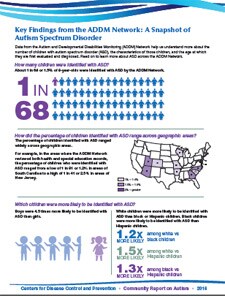New Data on Autism: Five Important Facts to Know
 Many children are living with autism spectrum disorder (ASD), and they need services and support, now and as they grow into adolescence and adulthood. More can be done to ensure that children with ASD are evaluated as soon as possible after developmental concerns are recognized. Read on to learn more about CDC’s new data on ASD.
Many children are living with autism spectrum disorder (ASD), and they need services and support, now and as they grow into adolescence and adulthood. More can be done to ensure that children with ASD are evaluated as soon as possible after developmental concerns are recognized. Read on to learn more about CDC’s new data on ASD.
Findings from CDC’s Autism and Developmental Disabilities Monitoring (ADDM) Network help us understand more about the number of children with autism spectrum disorder (ASD), the characteristics of those children, and the age at which these children are first evaluated and diagnosed. These findings are critical for
- Promoting early identification of children with ASD;
- Planning for services for children and families affected by ASD, and trainings for the professionals who provide those services;
- Guiding future ASD research; and
- Informing policies that promote improved outcomes in health care and education for individuals with ASD.
The highlights below are pulled from the most recent ADDM Network report, and are based on information collected from the health and special education (if available) records of 8-year-old children who lived in communities in Arizona, Arkansas, Colorado, Georgia, Maryland, Missouri, New Jersey, North Carolina, South Carolina, Utah, and Wisconsin in 2012.

To learn more about the latest findings on ASD, download the ADDM Key Findings PDF[310 KB].
Five Important Facts to Know
1. The estimated percentage of children with ASD remains high.
About 1 in 68 or 1.5% of children were identified with ASD based on tracking in 11 communities across the United States in 2012.
- According to previous reports, the percentage of children identified with ASD increased between 2002 and 2010.
- The new report shows no change between 2010 and 2012 in the percentage of children identified with ASD.
2. It is too soon to tell if the percentage of children identified with ASD is still increasing or has stabilized.
Here are two reasons why it is too soon to tell:
- While the average percentage of children identified with ASD in all 11 communities stayed the same, in 2 communities, the percentage of children identified with ASD increased significantly between 2010 and 2012.
- The percentage of children identified with ASD ranged widely by community— in communities where both health and special education records were reviewed, estimates ranged from a low of 1.2% in parts of South Carolina to a high of 2.4% in parts of New Jersey.
CDC will continue to track ASD over time so as to better understand if the percentage of children identified with ASD is staying the same or continuing to increase.
3. Children identified with ASD are not receiving comprehensive developmental evaluations1 as early as they could be.
Most children identified with ASD had concerns about their development noted in their health and/or special education records by age 3 years. Yet, less than half of children with ASD received a comprehensive developmental evaluation by this same age. A lag between first concern and first comprehensive developmental evaluation may affect when children are being diagnosed and connected to the services they need.
4. Black and Hispanic children are less likely to be identified with ASD. Those that are identified with ASD receive comprehensive developmental evaluations later than white children who are identified with ASD.
Previous research has not shown that black or Hispanic children have a lower risk than white children to develop ASD. However, since ADDM data showed that black and Hispanic children were less likely to be identified with ASD, it is possible that these children face socioeconomic or other barriers resulting in a lack of or delayed access to evaluation, diagnosis, and services.
5. Schools play a vital role in evaluating and serving children with ASD.
The percentage of children identified with ASD was highest in all communities combined where both health and special education records were reviewed compared to all communities combined where only health records were reviewed.
What Can Concerned Parents Do?
Parents should take two important steps if they suspect their child might have ASD:
- Talk to their child’s healthcare provider about their concerns.
- Call their local early intervention program or school system for a free evaluation of their child.
Parents should remember, it is never too late to get help for their child, and an ASD diagnosis from a doctor is not necessary for a child to begin receiving some types of services. For more tips about what parents and others can do when there is a concern, visit the If You’re Concerned website.
References
- A comprehensive, developmental evaluation is a thorough review of how a child plays, learns, communicates, acts, and moves, and whether those characteristics have changed over time. A range of professionals, including teachers, social workers, nurses, psychologists, doctors, and speech-language pathologists, can conduct developmental evaluations. The results of a developmental evaluation are often used by specialists, such as developmental pediatricians, to determine if a child has ASD.
More Information
Read the full scientific report “Prevalence and characteristics of autism spectrum disorder among children aged 8 years—Autism and Developmental Disabilities Monitoring Network, eleven sites, United States, 2012“
- Learn more about ASD
- Access free resources for parents, health professionals, childcare providers, and educators who work with children.
- Learn more about CDC’s ongoing ASD tracking system, the Autism and Developmental Disabilities Monitoring (ADDM) Network.



